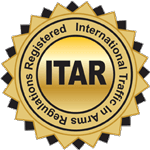Modern precision machining involves hardware and software to design and manufacture components or other machined products. Parts that have been precision machined feature stricter controls during production to maintain tight tolerances even under extreme conditions. For the most part, the precision machining process involves fabricating smaller components that must fit into a complex piece of equipment to ensure better durability and functionality. This entails more than just engineered tooling; it also extends to software that aids in designing, manufacturing, and assembly of precisely machined components.
While automation has largely replaced manual machining for precision parts, manual machining is still used for certain applications. However, CNC machining capabilities have developed rapidly in the 21st century. With new technologies, some automation is used in almost all precision machined components. When comparing CNC vs. manual machining, CNC manufacturing techniques allow quicker fabrication and more efficient use of resources. Yet it’s important for manufacturers who depend on precision machined parts to compare the differences between CNC and manual machining to determine which will work best for their specific application.
Comparing CNC vs. Manual Machining
Modern machine shops understand the importance of having alternatives from which customers can choose when considering the best manufacturing methods for a project. Manual machining shouldn’t be dismissed out of hand, as there’s still a place for manual techniques in precision machining. When comparing CNC vs. manual machining regarding the making of custom prototypes, for example, sometimes it’s better done with the latter method.
CNC technology requires digitized instructions that are programmed into a CNC machine. This guides the pathways of the machine’s cutting tools, which sophisticated software interprets and puts into action. This process involves the development of digital tool libraries that allow machinists and engineers to directly interact with and direct the pathways of a machine’s tooling.
Because of the technical development of CNC technology this century, CNC machining has emerged as the go-to method for automated machining. CNC machining uses software that controls turning, milling, EDM (electrical discharge machining), and other machines to remove layers of a workpiece. Also referred to as subtractive manufacturing, CNC machining operations depend on design software to create three-dimensional digital models that are then used to create the programs that ultimately determine a workpiece’s dimensions.
In contrast, manual machining standards involve using hand-operated tools like lathes, grinders, endmills, drill presses, and bandsaws. Machinists often use manual machining techniques to create one-off prototypes to help understand how a part or product will look or function in the real world. However, machining by hand also involves much greater time, skill, and attention. These are the main ways in which CNC and manual machining differ.
Advantages of CNC Machining
When comparing CNC vs. manual machining methods, it’s important to consider the benefits of each. A prime example is the versatile nature of CNC machining, which can be used for a wide variety of metals, alloys, and other materials to produce products and parts with consistent dimensions. Automation also lowers labor costs, allowing a single operator to oversee the tasks of several machines at once.
Further, as the pathways of tools are preprogrammed, CNC machining also offers greater speed and reliability than manual machining. With the need for less human labor, fewer incidents of error will be made by machinists as well. The need for fewer workers also increases safety. CNC machine operators manage equipment from a distance, and modern CNC machines can even change tooling automatically. CNC machines require less repair, so manufacturers generally experience lower maintenance costs.
Applications and industries that use CNC machining include:
- Artistic design: The precision inherent in CNC technology allows operators to control decorative designs on metals, alloys, and other materials precisely.
- Electronics: CNC machining fabricates various electronic devices and components, including fixtures, housings, microphones, printed circuit boards, and smartphones.
- Finishing: Comparing CNC vs. manual machining processes shows that these automated processes for finishing components allow manufacturers to optimize their operations while ensuring smoother surfaces and greater accuracy.
- Medical industry: The need for accuracy and quality in the complex parts of the medical industry extends to imaging equipment, monitors for X-rays, surgical implements, and various other medical equipment.
- Mold manufacturing: Injection and other molding techniques for plastic resins and composites depend on CNC machining processes to produce molds for mass production through precise and repeatable machining operations.
- Oil and gas industry: The tight tolerances and precision needed in the oil and gas sector require the capabilities of CNC machines, which are used for manufacturing pins, pistons, rods, and other machined parts.
- Part fabrication: Using design and other computer-aided software, parts manufacturers can optimize the production of components, saving time and money on research and development while improving operational efficiency.
When comparing the results of automated processes to more labor-intensive methods, CNC machining largely beats manual machining for consistency, cost-efficiency, quality, and reliability. This is why the CNC machining process is integral to modern manufacturing.
Benefits of Manual Machining
Though there’s a great deal to be said about CNC technology, manual machining still has its place in fabricating precision parts. For smaller production runs, manual machining can be less costly than CNC machining of parts, for example. Additionally, manual machining of simpler metal shapes also costs less.
Applications and industries that use manual machining include:
- Aerospace: Certain components in both aircraft and spacecraft still utilize manual machining, including landing gear, engine parts, and other critical components requiring a high degree of precision.
- Medical: Surgical implements and medical devices often require manual machining to meet exacting specifications.
- Metal fabrication: Cutting, drilling, shaping, and other operations in manufacturing parts from metals or alloys still use manual machining methods.
Machine shops still use manual machining techniques to fabricate custom components for various industries. Manual machining still has its place for many applications that require precision components, so will likely remain a part of the wheelhouse for many machine shops for years to come.
CNC vs. Manual Machining Costs
When looking at just a cost comparison between CNC vs. manual machining methods, manual machining seems to cost significantly less – CNC machining is almost double the hourly rate and escalating expenses as the complexity of the workpiece increases. Yet, the output for a CNC machine is exponentially higher than that achieved via manual machining.
There are a few other differences when comparing CNC vs. manual machining costs. Though manual machining costs less overall, factors like labor, maintenance, and scrap rates bring these two techniques closer in cost. Along with these elements and the total parts produced by each method, the cost of using CNC technology is less expensive than manual machining in most cases. Manual machining will have higher labor and maintenance costs. Because CNC machining is more accurate, it produces less waste than manual machining.
The Staub Advantage: CNC vs. Manual Machining
While Staub Precision Machine Inc. provides manual deburring and other finishing services, our company’s reputation is largely built around our automated capabilities. Staub is dedicated to decreasing variability and enhancing efficiency in production with sophisticated automation that allows us to use lights-out manufacturing methods. We want to increase our automated processes to produce more consistent parts with greater accuracy and quality. To learn more about our automated and other capabilities, contact one of Staub’s friendly representatives today.



